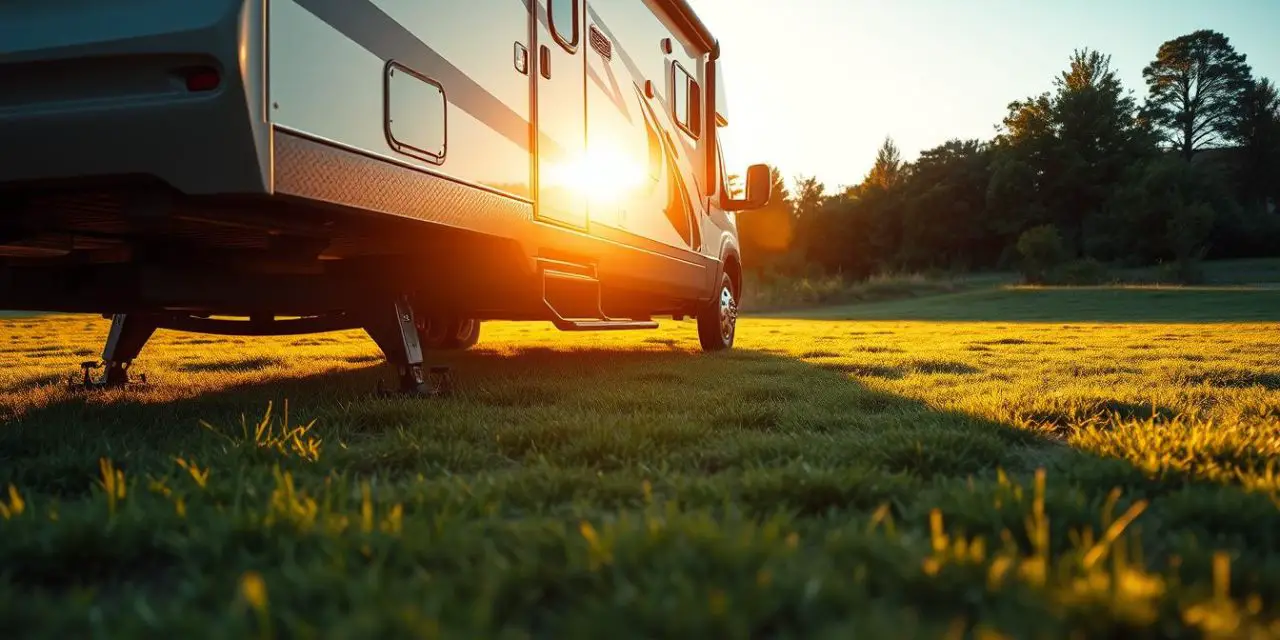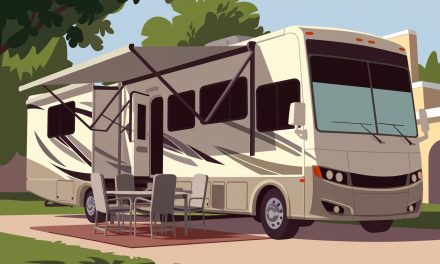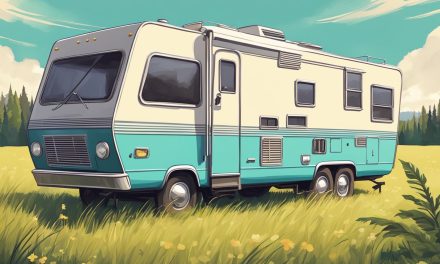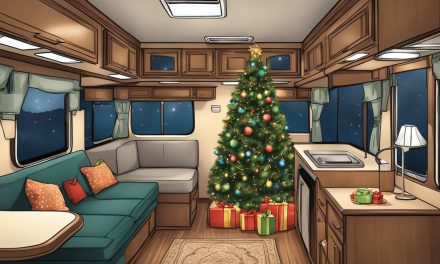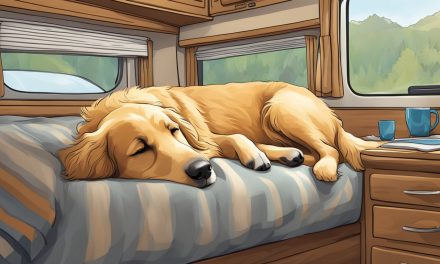Would you like to save this article?
Did you know that improperly leveling your RV can lead to significant discomfort and even damage to your rig? Many RV owners face confusion about whether they should level their RV with slides extended or retracted, with conflicting advice from manufacturers and fellow campers.
The rise of auto-leveling systems has revolutionized the camping experience, making setup faster and more precise than manual methods using jacks. However, the question remains: should you level your RV with slides out or in? This comprehensive guide will explore the pros and cons of auto-leveling with slides out, examining manufacturer recommendations and real-world experiences to provide clear, actionable advice.
Key Takeaways
- Understanding the relationship between slides and leveling is crucial for maintaining your RV’s structural integrity.
- Auto-leveling systems have made setup faster and more precise than manual methods.
- The decision to level with slides out or in depends on various factors, including the type of auto-leveling system and ground conditions.
- Manufacturer recommendations and real-world experiences provide valuable insights into the best leveling process.
- Proper leveling ensures a comfortable camping experience and prevents potential damage to your rig.
Understanding RV Auto Leveling Systems
RV auto leveling systems have revolutionized the way we park our recreational vehicles. These systems have made it possible to achieve perfect leveling with minimal effort, enhancing the overall camping experience.
How Auto Leveling Systems Work
Auto leveling systems in RVs utilize hydraulic or electric jacks to automatically adjust the vehicle’s position until it’s perfectly level. This process eliminates the guesswork associated with manual leveling. The systems employ multiple sensors that detect the RV’s orientation relative to the ground, sending data to a central control unit. Most modern auto leveling systems feature a one-touch operation, where pressing a single button initiates the entire leveling process.
The control panel typically displays real-time information about the RV’s level status and allows for manual overrides when needed. This level of control ensures that RV owners can fine-tune the level at any time, providing a stable and comfortable living environment.
Different Types of Auto Leveling Systems
There are primarily two types of auto leveling systems used in RVs: hydraulic and electric. Hydraulic leveling systems are common in higher-end RVs, offering powerful lifting capacity with smooth operation. Electric systems, on the other hand, are more prevalent in mid-range models, providing a reliable and efficient leveling solution.
Some advanced auto leveling systems include memory functions that can remember preferred leveling adjustments for frequently visited campsites. Understanding the specific type of system in your RV is crucial for proper operation and maintenance, as procedures can vary significantly between manufacturers.
Can You Auto Level RV with Slides Out?
The debate surrounding auto-leveling RVs with slides out has sparked intense discussion among RV owners and manufacturers. While some argue it’s safe, others claim it can cause significant damage to the RV’s structure.
Most RV manufacturers explicitly recommend leveling the rig before extending slides to prevent potential structural damage and ensure proper slide operation. This recommendation is based on the understanding that leveling with slides extended can put additional stress on the slide mechanisms.
Manufacturer Recommendations
RV manufacturers generally advise against auto-leveling with slides out due to the potential risks involved. However, some newer models with advanced leveling systems may accommodate this feature.
The primary concern is that the RV chassis shifts during the leveling process, causing stress on the slide mechanisms. Over time, this can lead to alignment issues, seal damage, and potential water leaks around slide openings.
| Manufacturer | Recommendation | System Capability |
|---|---|---|
| Brand A | Level before extending slides | Basic Leveling System |
| Brand B | Can level with slides out | Advanced Leveling System |
| Brand C | Level before extending slides | Basic Leveling System |
Potential Risks and Concerns
Leveling an RV with slides out can cause significant stress on the slide mechanisms, potentially leading to costly repairs. The risk is higher when the ground is severely uneven, requiring major leveling adjustments.
Key risks include: alignment issues, seal damage, and water leaks around slide openings.
Real-World Experiences from RV Owners
RV owners have reported mixed results when auto-leveling with slides out. Some have experienced no issues, while others have faced costly repairs.
One RV owner shared their experience: “After reading everyone’s input, I decided to pull the slides in and do an auto level. It worked great with very little movement!”
The decision to auto-level with slides out often depends on the RV’s specific leveling system, the terrain, and the owner’s experience. When in doubt, following manufacturer guidelines is always the safest approach.
The Best Practice Approach to RV Leveling
When it comes to RV leveling, following the best practices is crucial for a safe and enjoyable experience. Leveling your RV correctly ensures that your slides operate smoothly and that your rig remains stable. “Proper leveling is key to preventing damage to your RV’s systems and ensuring a comfortable stay,” says a seasoned RV owner.
The industry-standard best practice for RV leveling follows a specific sequence: position your RV, level it completely, and only then extend your slides. This approach minimizes stress on slide mechanisms and ensures they extend and retract on a level plane, preventing potential binding or misalignment issues.
Leveling Before Extending Slides
Leveling your RV before extending the slides is generally considered the best practice. This approach helps to prevent unnecessary stress on the slide mechanisms and ensures that they operate smoothly. By leveling your RV first, you can avoid potential problems such as binding or misalignment of the slides.
When It’s Safe to Level with Slides Out
While the best practice is to level your RV before extending the slides, there are situations where you might need to make adjustments with the slides out. Minor leveling adjustments (less than 1-2 inches) with slides extended generally pose minimal risk, especially for minor fine-tuning after initial setup. However, it’s essential to exercise caution and consider the specific conditions of your RV.
Factors That Affect Your Decision
Several factors influence whether you can safely level your RV with the slides out, including your RV’s construction quality, the specific auto-leveling system installed, and the amount of adjustment needed. For instance, older RVs with worn slide mechanisms may be more susceptible to damage when leveling with slides extended compared to newer models. Additionally, the weight distribution of your RV’s contents can significantly impact leveling needs, with heavily loaded slides creating additional stress during the leveling process.
By understanding these factors and following best practices, you can ensure a safe and enjoyable RV experience. Developing a consistent leveling routine based on your specific RV’s requirements will save time and prevent potential issues over the long term.
Step-by-Step Guide to Auto Leveling with Slides Extended
The ability to auto level your RV with slides extended offers flexibility, but it’s essential to follow a careful process to avoid potential risks. As RV owners, understanding the proper steps to level your vehicle with slides out is crucial for maintaining the integrity of your RV’s structure and ensuring a comfortable living space.
Preparation Steps
Before initiating the auto-leveling process, several preparation steps are necessary. First, ensure your RV is positioned on relatively level ground to minimize the adjustments needed during auto-leveling. Check that all slide-outs are fully extended and locked in position, with no obstructions that could cause binding during level adjustments.
Remove any items that might shift or fall during the leveling process, particularly on countertops or inside cabinets near slide mechanisms. This precaution helps prevent damage and ensures a safe leveling process.
The Auto Leveling Process
Once you’ve completed the preparation steps, you can begin the auto-leveling process. For most systems, this involves simply pressing the auto-level button, which will make the necessary adjustments to level your RV. It’s crucial to pay close attention to any unusual noises or resistance during the leveling process, as these could indicate stress on your slide mechanisms.
Fine-Tuning Your Level
After the initial auto-leveling process, you may need to make some fine-tuning adjustments. Many modern RVs, like mine, allow you to fine-tune the level at any time by hitting the HWH power-on button to turn the system on, then tapping the auto-level button again. This process will check and fine-tune the jacks, shutting down when finished. Alternatively, you can make manual adjustments as needed.
After leveling, visually inspect all slide seals to ensure they remain properly aligned and seated against the RV body. This step is crucial for maintaining the integrity of your RV’s seals and preventing potential leaks.
Troubleshooting Common Auto Leveling Issues
The auto leveling system in an RV, while convenient, can develop issues over time that need to be addressed. These problems can affect the system’s accuracy and overall performance, especially when leveling with slides extended.
Calibration Problems
Calibration issues are among the most common problems encountered with auto leveling systems. If your RV appears level according to the system but is noticeably off, recalibration may be necessary. Following the manufacturer’s specific procedure is crucial for accurate recalibration. For instance, if your RV’s front end is consistently too low or high, extending the front jacks and then recalibrating can resolve the issue.
Uneven Movement During Leveling
Uneven jack movement during the leveling process can indicate underlying issues such as hydraulic fluid problems, air in the lines, or electronic control faults. These issues require professional attention to prevent further damage to the system. Regular maintenance, including checking hydraulic fluid levels and inspecting for obstructions, can help mitigate these problems.
System Errors and How to Resolve Them
System errors often manifest as error codes on the control panel, indicating issues such as sensor failures or jack extension problems. Troubleshooting these errors involves checking for simple issues like low hydraulic fluid levels before assuming major system failures. Many modern systems have self-diagnostic capabilities accessible through specific button combinations on the control panel, aiding in the resolution of these issues.
To minimize troubleshooting needs and extend the system’s life, regular system inspections and hydraulic fluid changes are recommended. Keeping a log of recurring issues can also help technicians diagnose intermittent problems more effectively.
Conclusion
When it comes to auto leveling an RV with slides extended, there’s no universal answer, as it hinges on the specific RV and its equipment. The safest approach remains following manufacturer recommendations, which typically advise leveling before extending slides to protect your RV’s structural integrity. However, most modern auto leveling systems can make minor adjustments without requiring slide retraction.
Developing a consistent leveling routine based on your RV’s needs will save time and prevent potential damage. Proper leveling affects not just comfort, but also appliance operation and slide mechanism longevity. Many RVers find a hybrid approach works best: rough leveling before slides, then fine-tuning after. Regular inspection of slide seals and mechanisms is also crucial. By following these guidelines and consulting with your RV manufacturer when needed, you can ensure a safe and enjoyable RV experience.

